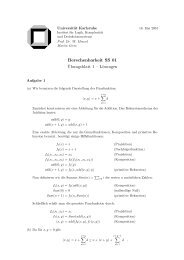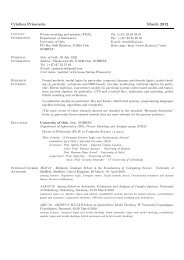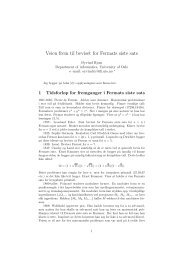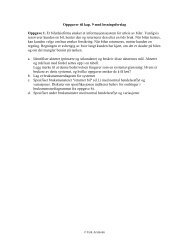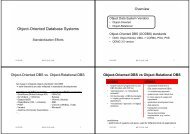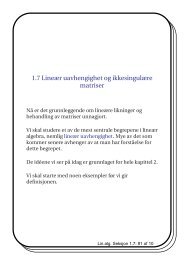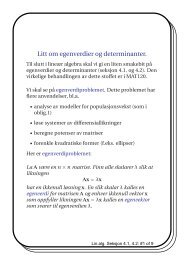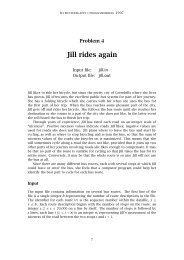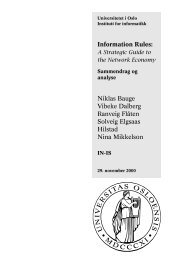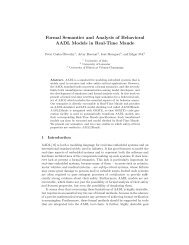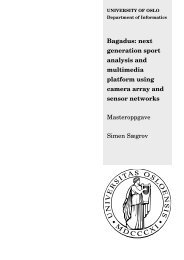Timed CTL Model Checking in Real-Time Maude⋆ - IfI
Timed CTL Model Checking in Real-Time Maude⋆ - IfI
Timed CTL Model Checking in Real-Time Maude⋆ - IfI
Create successful ePaper yourself
Turn your PDF publications into a flip-book with our unique Google optimized e-Paper software.
<strong><strong>Time</strong>d</strong> <strong>CTL</strong> <strong>Model</strong> <strong>Check<strong>in</strong>g</strong> <strong>in</strong> <strong>Real</strong>-<strong>Time</strong> Maude 13<br />
The real-time rewrite theory R gcd(t0,r,ϕ) is obta<strong>in</strong>ed from the tick-robust realtime<br />
rewrite theory R, a state t0 <strong>in</strong> R, and a T<strong>CTL</strong> formula ϕ, by advanc<strong>in</strong>g<br />
time by “half” the greatest common divisor of all the follow<strong>in</strong>g values:<br />
– all tick step durations appear<strong>in</strong>g <strong>in</strong> paths from tfPaths R maxDef (r)(t0) and<br />
– all f<strong>in</strong>ite non-zero lower and upper bounds of all temporal operators <strong>in</strong> ϕ.<br />
Def<strong>in</strong>ition 6. For a real-time rewrite theory R whose time doma<strong>in</strong> satisfies the<br />
theory GCD-TIME-DOMAIN, a non-zero time value r, a T<strong>CTL</strong> formula ϕ and a<br />
state t0 of R we def<strong>in</strong>e<br />
T1(R, t0, r) = {r ′ ∈ Nz<strong>Time</strong> | ∃π ∈ tfPaths R maxDef (r)(t0). ∃i ≥ 0. r ′ = r π i }<br />
T2(ϕ) = {r ∈ Nz<strong>Time</strong> | there exists a subformula E ϕ1 UI ϕ2 or<br />
GCD(R, r, ϕ, t0) = gcd(T1(R, t0, r) ∪ T2(ϕ)).<br />
A ϕ1 UI ϕ2 of ϕ with r a non-zero f<strong>in</strong>ite<br />
lower or upper bound <strong>in</strong> I}<br />
If T1(R, t0, r) and T2(ϕ) are f<strong>in</strong>ite then the GCD value is well-def<strong>in</strong>ed and<br />
we can def<strong>in</strong>e the real-time rewrite theory R gcd(t0,r,ϕ) as follows:<br />
Def<strong>in</strong>ition 7. Given a real-time rewrite theory R whose time doma<strong>in</strong> satisfies<br />
the theory GCD-TIME-DOMAIN, a non-zero time value r, a T<strong>CTL</strong> formula ϕ, a<br />
state t0 of R, and assume that ¯r = GCD(R, t0, r, ϕ) is a def<strong>in</strong>ed non-zero time<br />
value. Then R gcd(t0,r,ϕ) is def<strong>in</strong>ed as R but where each tick rule of the forms (†),<br />
(∗), and (§) is replaced by the respective tick rule:<br />
crl [tick] : {t} => {t ′ } <strong>in</strong> time x if x := half (¯r) /\ cond [nonexec] .<br />
crl [tick] : {t} => {t ′ } <strong>in</strong> time x if x := half (¯r) /\ cond [nonexec] .<br />
crl [tick] : {t} => {t ′ } <strong>in</strong> time x if x := half (¯r) [nonexec] .<br />
The follow<strong>in</strong>g lemma states that the evaluation of the formula ϕ and its<br />
subformulas does not change <strong>in</strong>side tick steps of R gcd(t0,r,ϕ) .<br />
Lemma 1. Assume a time-robust real-time rewrite theory R whose time doma<strong>in</strong><br />
satisfies the theory GCD-TIME-DOMAIN. Let Π be a set of tick-<strong>in</strong>variant atomic<br />
propositions, and assume a protect<strong>in</strong>g extension of R def<strong>in</strong><strong>in</strong>g the atomic propositions<br />
<strong>in</strong> Π and <strong>in</strong>duc<strong>in</strong>g a label<strong>in</strong>g function LΠ. Let t0 be a state of R, r a<br />
non-zero time value of sort <strong>Time</strong>, ϕ a T<strong>CTL</strong>cb formula over Π, and assume that<br />
¯r = GCD(R, t0, r, ϕ) is a def<strong>in</strong>ed non-zero time value.<br />
Then for each subformula ϕ ′ of ϕ, each time-divergent path π ∈ tfPathsR(t0) r π<br />
i<br />
and for all tick step sequences tπ i −→ . . . rπ<br />
j−1<br />
−→ tπ j <strong>in</strong> π satisfy<strong>in</strong>g n· ¯r < dπi < dπj <<br />
(n + 1) · ¯r for some n we have that<br />
R, LΠ, t π i |=c ϕ ′<br />
iff R, LΠ, t π j |=c ϕ ′ .<br />
Proof. In the follow<strong>in</strong>g we use N0 and N for the set of all natural numbers<br />
<strong>in</strong>clud<strong>in</strong>g resp. exclud<strong>in</strong>g 0. The proof is by <strong>in</strong>duction on the structure of ϕ ′ .<br />
Base cases:



